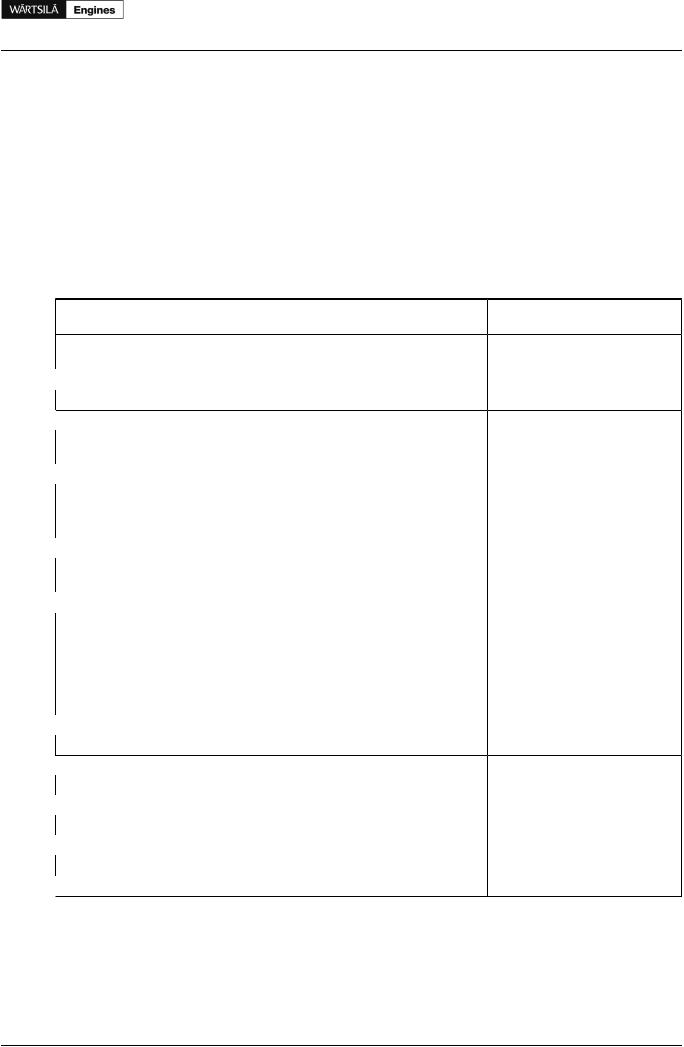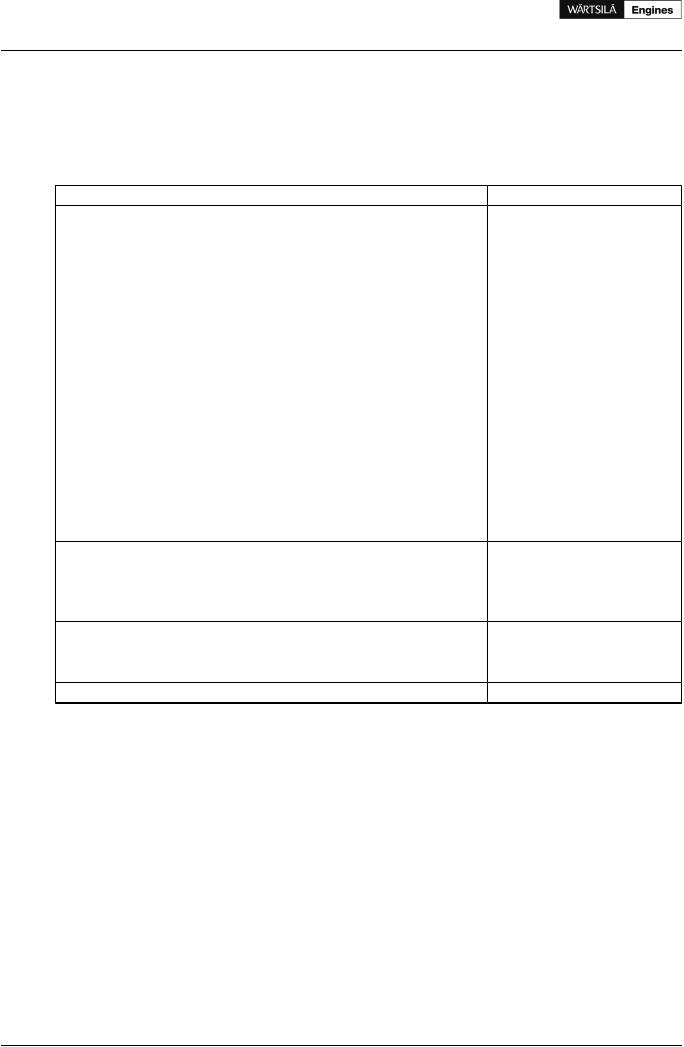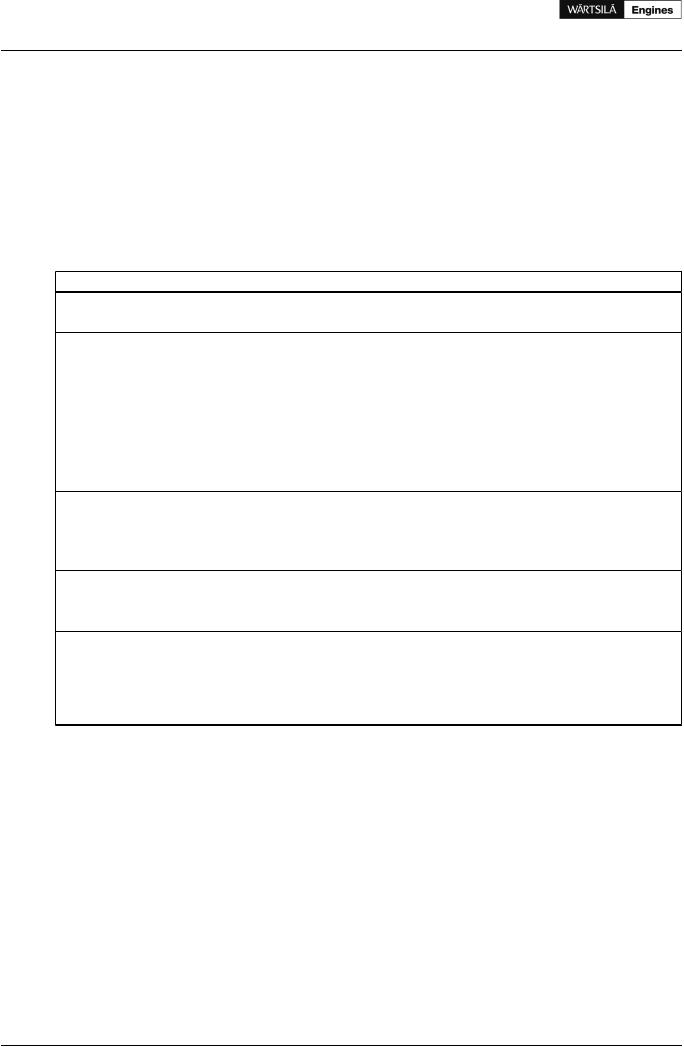
- •Introduction
- •Table of Contents
- •1. Main Data and Outputs
- •1.1 Maximum continuous output
- •1.2 Reference conditions
- •1.3 Operation in inclined position
- •1.4 Dimensions and weights
- •2. Operating ranges
- •2.1 Engine operating range
- •2.2 Loading capacity
- •2.3 Low air temperature
- •2.4 Operation at low load and idling
- •3. Technical Data
- •3.1 Wärtsilä 4L20
- •3.2 Wärtsilä 6L20
- •3.3 Wärtsilä 8L20
- •3.4 Wärtsilä 9L20
- •4. Description of the Engine
- •4.1 Definitions
- •4.2 Main components and systems
- •4.3 Cross sections of the engine
- •4.4 Overhaul intervals and expected lifetimes
- •5. Piping Design, Treatment and Installation
- •5.1 Pipe dimensions
- •5.2 Trace heating
- •5.3 Operating and design pressure
- •5.4 Pipe class
- •5.5 Insulation
- •5.6 Local gauges
- •5.7 Cleaning procedures
- •5.8 Flexible pipe connections
- •5.9 Clamping of pipes
- •6. Fuel Oil System
- •6.1 Acceptable fuel characteristics
- •6.2 Internal fuel oil system
- •6.3 External fuel oil system
- •7. Lubricating Oil System
- •7.1 Lubricating oil requirements
- •7.2 Internal lubricating oil system
- •7.3 External lubricating oil system
- •7.4 Crankcase ventilation system
- •7.5 Flushing instructions
- •8. Compressed Air System
- •8.1 Internal compressed air system
- •8.2 External compressed air system
- •9. Cooling Water System
- •9.1 Water quality
- •9.2 Internal cooling water system
- •9.3 External cooling water system
- •10. Combustion Air System
- •10.1 Engine room ventilation
- •10.2 Combustion air system design
- •11. Exhaust Gas System
- •11.1 Internal exhaust gas system
- •11.2 Exhaust gas outlet
- •11.3 External exhaust gas system
- •12. Turbocharger Cleaning
- •12.1 Turbine cleaning system
- •12.2 Compressor cleaning system
- •13. Exhaust Emissions
- •13.1 Diesel engine exhaust components
- •13.2 Marine exhaust emissions legislation
- •13.3 Methods to reduce exhaust emissions
- •14. Automation System
- •14.1 UNIC C1
- •14.2 UNIC C2
- •14.3 Functions
- •14.4 Alarm and monitoring signals
- •14.5 Electrical consumers
- •15. Foundation
- •15.1 Steel structure design
- •15.2 Mounting of main engines
- •15.3 Mounting of generating sets
- •15.4 Flexible pipe connections
- •16. Vibration and Noise
- •16.1 External forces and couples
- •16.2 Mass moments of inertia
- •16.3 Structure borne noise
- •16.4 Air borne noise
- •17. Power Transmission
- •17.1 Flexible coupling
- •17.2 Clutch
- •17.3 Shaft locking device
- •17.4 Power-take-off from the free end
- •17.5 Input data for torsional vibration calculations
- •17.6 Turning gear
- •18. Engine Room Layout
- •18.1 Crankshaft distances
- •18.2 Space requirements for maintenance
- •18.3 Transportation and storage of spare parts and tools
- •18.4 Required deck area for service work
- •19. Transport Dimensions and Weights
- •19.1 Lifting of engines
- •19.2 Engine components
- •20. Product Guide Attachments
- •21. ANNEX
- •21.1 Unit conversion tables
- •21.2 Collection of drawing symbols used in drawings

Product Guide
6. Fuel Oil System
6.Fuel Oil System
6.1Acceptable fuel characteristics
The fuel specifications are based on the ISO 8217:2005 (E) standard. Observe that a few additional properties not included in the standard are listed in the tables.
Distillate fuel grades are ISO-F-DMX, DMA, DMB, DMC. These fuel grades are referred to as MDF (Marine Diesel Fuel).
Residual fuel grades are referred to as HFO (Heavy Fuel Oil). The fuel specification HFO 2 covers the categories ISO-F-RMA 30 to RMK 700. Fuels fulfilling the specification HFO 1 permit longer overhaul intervals of specific engine components than HFO 2.
Table 6.1 MDF specifications
Property
Appearance
 Viscosity, before injection pumps, min. 2)
Viscosity, before injection pumps, min. 2)
Viscosity, before injection pumps, max. 2)
 Viscosity at 40°C, max. Density at 15°C, max.
Viscosity at 40°C, max. Density at 15°C, max.
 Cetane index, min.
Cetane index, min.
Water, max.
Sulphur, max.
 Ash, max.
Ash, max.
Vanadium, max.
 Sodium before engine, max. 2)
Sodium before engine, max. 2)
Aluminium + Silicon, max
Aluminium + Silicon before engine, max. 2)
Carbon residue on 10 % volume distillation bottoms, max.
 Carbon residue, max.
Carbon residue, max.
Flash point (PMCC), min.
 Pour point, winter quality, max.
Pour point, winter quality, max.
Pour point, summer quality, max
 Cloud point, max.
Cloud point, max.
Total sediment existent, max.
 Used lubricating oil, calcium, max. 4)
Used lubricating oil, calcium, max. 4)
Used lubricating oil, zinc, max. 4)
 Used lubricating oil, phosphorus, max. 4)
Used lubricating oil, phosphorus, max. 4)
Remarks:
Unit |
ISO-F- |
ISO-F- |
ISO-F- |
ISO-F- |
Test method |
|
DMX |
DMA |
DMB |
DMC 1) |
ref. |
|
Clear and bright |
- |
- |
Visual |
|
|
|
|
|
|
inspection |
cSt |
1.8 |
1.8 |
1.8 |
1.8 |
ISO 3104 |
cSt |
24 |
24 |
24 |
24 |
ISO 3104 |
cSt |
5.5 |
6.0 |
11.0 |
14.0 |
ISO 3104 |
kg/m³ |
— |
890 |
900 |
920 |
ISO 3675 or |
|
|
|
|
|
12185 |
|
45 |
40 |
35 |
— |
ISO 4264 |
% volume |
— |
— |
0.3 |
0.3 |
ISO 3733 |
% mass |
1.0 |
1.5 |
2.0 3) |
2.0 3) |
ISO 8574 or |
|
|
|
|
|
14596 |
% mass |
0.01 |
0.01 |
0.01 |
0.05 |
ISO 6245 |
mg/kg |
— |
— |
— |
100 |
ISO 14597 or |
|
|
|
|
|
IP 501 or 470 |
mg/kg |
— |
— |
— |
30 |
ISO 10478 |
mg/kg |
— |
— |
— |
25 |
ISO 10478 or |
|
|
|
|
|
IP 501 or 470 |
mg/kg |
— |
— |
— |
15 |
ISO 10478 or |
|
|
|
|
|
IP 501 or 470 |
% mass |
0.30 |
0.30 |
— |
— |
ISO 10370 |
% mass |
— |
— |
0.30 |
2.50 |
ISO 10370 |
°C |
60 2) |
60 |
60 |
60 |
ISO 2719 |
°C |
— |
-6 |
0 |
0 |
ISO 3016 |
°C |
— |
0 |
6 |
6 |
ISO 3016 |
°C |
-16 |
— |
— |
— |
ISO 3015 |
% mass |
— |
— |
0.1 |
0.1 |
ISO 10307-1 |
mg/kg |
— |
— |
— |
30 |
IP 501 or 470 |
mg/kg |
— |
— |
— |
15 |
IP 501 or 470 |
mg/kg |
— |
— |
— |
15 |
IP 501 or 500 |
1)Use of ISO-F-DMC category fuel is allowed provided that the fuel treatment system is equipped with a fuel centrifuge.
2)Additional properties specified by the engine manufacturer, which are not included in the ISO specification or differ from the ISO specification.
Product Guide Wärtsilä 20 - 3/2009 |
29 |

Product Guide
6.Fuel Oil System
3)A sulphur limit of 1.5% mass will apply in SOx emission controlled areas designated by IMO (International Maritime Organization). There may also be other local variations.
4)A fuel shall be considered to be free of used lubricating oil (ULO), if one or more of the elements calcium, zinc, and phosphorus are below or at the specified limits. All three elements shall exceed the same limits before a fuel shall be deemed to contain ULO's.
Table 6.2 HFO specifications |
|
|
|
|
Property |
Unit |
Limit HFO 1 |
Limit HFO 2 Test method ref. |
|
Viscosity at 100°C, max. |
cSt |
55 |
55 |
ISO 3104 |
Viscosity at 50°C, max. |
cSt |
700 |
700 |
|
Viscosity at 100°F, max |
Redwood No. 1 s |
7200 |
7200 |
|
Viscosity, before injection pumps 4) |
cSt |
16...24 |
16...24 |
|
Density at 15°C, max. |
kg/m³ |
991 / 1010 1) |
991 / 1010 1) |
ISO 3675 or 12185 |
CCAI, max.4) |
|
850 |
870 2) |
ISO 8217, Annex B |
Water, max. |
% volume |
0.5 |
0.5 |
ISO 3733 |
Water before engine, max.4) |
% volume |
0.3 |
0.3 |
ISO 3733 |
Sulphur, max. |
% mass |
1.5 |
4.5 5) |
ISO 8754 or 14596 |
Ash, max. |
% mass |
0.05 |
0.15 |
ISO 6245 |
Vanadium, max. 3) |
mg/kg |
100 |
600 3) |
ISO 14597 or IP 501 |
|
|
|
|
or 470 |
Sodium, max. 3,4) |
mg/kg |
50 |
50 |
ISO 10478 |
Sodium before engine, max.3,4) |
mg/kg |
30 |
30 |
ISO 10478 |
Aluminium + Silicon, max. |
mg/kg |
30 |
80 |
ISO 10478 or IP 501 |
|
|
|
|
or 470 |
Aluminium + Silicon before engine, max.4) |
mg/kg |
15 |
15 |
ISO 10478 or IP 501 |
|
|
|
|
or 470 |
Carbon residue, max. |
% mass |
15 |
22 |
ISO 10370 |
Asphaltenes, max.4) |
% mass |
8 |
14 |
ASTM D 3279 |
Flash point (PMCC), min. |
°C |
60 |
60 |
ISO 2719 |
Pour point, max. |
°C |
30 |
30 |
ISO 3016 |
Total sediment potential, max. |
% mass |
0.10 |
0.10 |
ISO 10307-2 |
Used lubricating oil, calcium, max. 6) |
mg/kg |
30 |
30 |
IP 501 or 470 |
Used lubricating oil, zinc, max. 6) |
mg/kg |
15 |
15 |
IP 501 or 470 |
Used lubricating oil, phosphorus, max. 6) |
mg/kg |
15 |
15 |
IP 501 or 500 |
Remarks:
1)Max. 1010 kg/m³ at 15°C provided the fuel treatment system can remove water and solids.
2)Straight run residues show CCAI values in the 770 to 840 range and have very good ignition quality. Cracked residues delivered as bunkers may range from 840 to - in exceptional cases - above 900. Most bunkers remain in the max. 850 to 870 range at the moment.
3)Sodium contributes to hot corrosion on exhaust valves when combined with high sulphur and vanadium contents. Sodium also contributes strongly to fouling of the exhaust gas turbine at high loads. The aggressiveness of the fuel depends not only on its proportions of sodium and vanadium but also on the total amount of ash constituents. Hot corrosion and deposit formation are, however, also influenced by other ash constituents. It is therefore difficult to set strict limits based only on the sodium and vanadium content of the fuel. Also a fuel with lower sodium and vanadium contents that specified above, can cause hot corrosion on engine components.
4)Additional properties specified by the engine manufacturer, which are not included in the ISO specification.
5)A sulphur limit of 1.5% mass will apply in SOx emission controlled areas designated by IMO (International Maritime Organization). There may also be other local variations.
6)A fuel shall be considered to be free of used lubricating oil (ULO), if one or more of the elements calcium, zinc, and phosphorus are below or at the specified limits. All three elements shall exceed the same limits before a fuel shall be deemed to contain ULO's.
30 |
Product Guide Wärtsilä 20 - 3/2009 |

Product Guide
6. Fuel Oil System
The limits above concerning HFO 2 also correspond to the demands of the following standards:
•BS MA 100: 1996, RMH 55 and RMK 55
•CIMAC 2003, Grade K 700
•ISO 8217: 2005(E), ISO-F-RMK 700
The fuel shall not contain any added substances or chemical waste, which jeopardizes the safety of installations or adversely affects the performance of the engines or is harmful to personnel or contributes overall to air pollution.
Product Guide Wärtsilä 20 - 3/2009 |
31 |

Product Guide
6. Fuel Oil System
6.1.1 Liquid bio fuels
The engine can be operated on liquid bio fuels according to the specifications in tables "6.3 Crude liquid bio fuel specification" or "6.4 Biodiesel specification based on EN 14214:2003 standard". Liquid bio fuels have typically lower heating value than fossil fuels, the capacity of the fuel injection system must be checked for each installation.
Table "Crude liquid bio fuel specification" is valid for crude vegetable based liquid bio fuels, like palm oil, coconut oil, copra oil, rape seed oil, jathropha oil etc. but is not valid for other bio fuel qualities like animal fats.
Renewable biodiesel can be mixed with fossil distillate fuel. Fossil fuel being used as a blending component has to fulfill the requirement described earlier in this chapter.
Table 6.3 Crude liquid bio fuel specification |
|
|
|
Property |
Unit |
Limit |
Test method ref. |
Viscosity at 40°C, max.1) |
cSt |
100 |
ISO 3104 |
Viscosity, before injection pumps, min. |
cSt |
1.8 |
|
Viscosity, before injection pumps, max. |
cSt |
24 |
|
Density at 15°C, max. |
kg/m³ |
991 |
ISO 3675 or 12185 |
Ignition properties 2) |
|
|
FIA test |
Sulphur, max. |
% mass |
0.05 |
ISO 8574 |
Total sediment existent, max. |
% mass |
0.05 |
ISO 10307-1 |
Water before engine, max. |
% volume |
0.20 |
ISO 3733 |
Micro carbon residue, max. |
% mass |
0.50 |
ISO 10370 |
Ash, max. |
% mass |
0.05 |
ISO 6245 / LP1001 |
Phosphorus, max. |
mg/kg |
100 |
ISO 10478 |
Silicon, max. |
mg/kg |
15 |
ISO 10478 |
Alkali content (Na+K), max. |
mg/kg |
30 |
ISO 10478 |
Flash point (PMCC), min. |
°C |
60 |
ISO 2719 |
Cloud point, max. |
°C |
3) |
ISO 3015 |
Cold filter plugging point, max. |
°C |
3) |
IP 309 |
Copper strip corrosion (3h at 50°C), max. |
|
1b |
ASTM D130 |
Steel corrosion (24/72h at 20, 60 and 120°C), max. |
|
No signs of corrosion |
LP 2902 |
Acid number, max. |
mg KOH/g |
15.0 |
ASTM D664 |
Strong acid number, max. |
mg KOH/g |
0.0 |
ASTM D664 |
Iodine number, max. |
g iodine / |
120 |
ISO 3961 |
|
100 g |
|
|
Remarks:
1)If injection viscosity of max. 24 cSt cannot be achieved with an unheated fuel, fuel oil system has to be equipped with a heater.
2)Ignition properties have to be equal to or better than requirements for fossil fuels, i.e. CN min. 35 for MDF and CCAI max. 870 for HFO.
3)Cloud point and cold filter plugging point have to be at least 10°C below the fuel injection temperature.
32 |
Product Guide Wärtsilä 20 - 3/2009 |

|
|
|
Product Guide |
|
|
|
6. Fuel Oil System |
Table 6.4 Biodiesel specification based on EN 14214:2003 standard |
|
|
|
Property |
Unit |
Limit |
Test method ref. |
Viscosity at 40°C, min...max. |
cSt |
3.5...5 |
ISO 3104 |
Viscosity, before injection pumps, min. |
cSt |
1.8 |
|
Density at 15°C, min...max. |
kg/m³ |
860...900 |
ISO 3675 / 12185 |
Cetane number, min. |
|
51 |
ISO 5165 |
Sulphur, max. |
mg/kg |
10 |
ISO 20846 / 20884 |
Sulphated ash, max. |
% mass |
0.02 |
ISO 3987 |
Total contamination, max. |
mg/kg |
24 |
EN 12662 |
Water, max. |
mg/kg |
500 |
ISO 12937 |
Carbon residue (on 10% distillation residue), max. |
% mass |
0.30 |
ISO 10370 |
Phosphorus, max. |
mg/kg |
10 |
EN 14107 |
Group 1 metals (Na+K), max. |
mg/kg |
5 |
EN 14108 / 14109 |
Group 2 metals (Ca+Mg), max. |
mg/kg |
5 |
EN 14538 |
Flash point, min. |
°C |
120 |
ISO 3679 |
Cold filter plugging point, max. 2) |
°C |
-44...+5 |
EN 116 |
Oxidation stability at 110°C, min. |
h |
6 |
EN 14112 |
Copper strip corrosion (3h at 50°C), max. |
|
Class 1 |
ISO 2160 |
Steel corrosion (24/72h at 20, 60 and 120°C), max. |
|
No signs of corrosion |
LP 2902 |
Acid number, max. |
mg KOH/g |
0.5 |
EN 14104 |
Iodine number, max. |
g iodine / |
120 |
EN 14111 |
|
100 g |
|
|
Ester content, min |
% mass |
96.5 |
EN 14103 |
Linolenic acid methyl ester, max. |
% mass |
12 |
EN 14103 |
Polyunsaturated methyl esters, max. |
% mass |
1 |
|
Methanol content, max. |
% mass |
0.2 |
EN 14110 |
Monoglyceride content, max. |
% mass |
0.8 |
EN 14105 |
Diglyceride content, max. |
% mass |
0.2 |
EN 14105 |
Triglyceride content, max. |
% mass |
0.2 |
EN 14105 |
Free glycerol, max. |
% mass |
0.02 |
EN 14105 / 14106 |
Total glycerol, max. |
% mass |
0.25 |
EN 14105 |
Remarks:
1)Cold flow properties of renewable bio diesel can vary based on the geographical location and also based on the feedstock properties, which issues must be taken into account when designing the fuel system.
Product Guide Wärtsilä 20 - 3/2009 |
33 |
